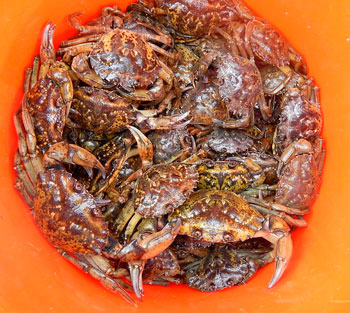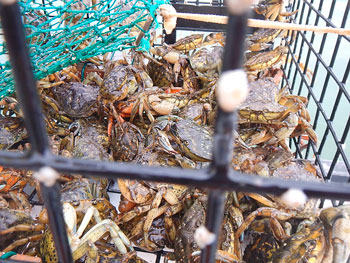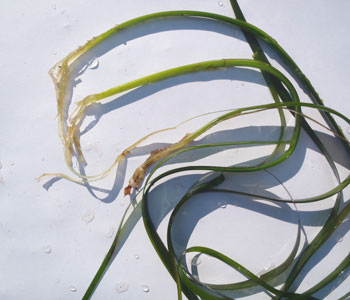Green Crabs: The Hods Are Mobbed
by Laurie Schreiber

Green crabs from Berry Cove, seen here in a bucket. As an invasive species, green crabs have been on the DMR’s tracking radar through the decades. Surveys were conducted regularly in the 1960s and 1970s, but were discontinued over the last 15 years. Laurie Schreiber photo
ELLSWORTH – Reports are coming in that “horror movie” numbers of green crabs are ranging up the Maine coast and preying on the state’s valuable shellfish resource.
Unfortunately, the invader itself doesn’t seem to be a tasty species. Otherwise, their growing abundance would have been a great opportunity to develop a new market.
That was the word from Department of Marine Resources (DMR) officials and the DMR’s Shellfish Advisory Council, who discussed the subject earlier this summer.
“People are saying the hods are getting mobbed by green crabs, if they leave them in the water,” said DMR public health bureau director Kohl Kanwit. “There seems to be a lot of validity to the reports, certainly in certain areas.”
Kanwit said the problem, possibly driven by warming ocean temperatures, seems to be increasing. One shellfish advisor said the count of green crabs in a typical harvest is far outnumbering native crabs.
“There are hot spots,” said Denis-Marc Nault, a DMR municipal shellfish program supervisor who covers southern towns from Eliot to Old Orchard Beach and eastern towns from Milbridge to Calais. “We’ve got to try to identify where the hot spots are, and why. Northern Bay in Penobscot is in complete collapse.”
A recent survey of clams in the bay, once rich with clams, showed only 20 live individuals, along with pieces of shell, Nault said. “It’s not like those clams are dying of places that were chipped, so it’s a clear sign of that product being eaten. We can capture seed in those areas, high volumes of seed. But if that seed gets nailed by the green crabs, there’s your entire year gone.”
A DMR overview of the situation, issued in July, said green crabs have been present in Maine for more than a century. Studies suggest the animals originally hail from Europe, perhaps reaching U.S. shores in the mid-1800s after riding across the Atlantic in the ballast water on ships.
As an invasive species, green crabs have been on the DMR’s tracking radar through the decades. Surveys were conducted regularly in the 1960s and 1970s, but were discontinued over the last 15 years.
“The green crab population in some areas of Maine has increased dramatically in recent years, and they have been feeding on shellfish resources such as blue mussels and soft-shell clams, threatening the state’s third-largest wild fishery,” the DMR said. “Recent anecdotal information indicates green crabs are expanding into subtidal habitats.”
The increase in the population coincides with an increase in ocean temperatures, the DMR said.
“A similar cycle occurred in the early 1950s when the ocean temperatures rose and the green crab population increased, devastating the soft-shell clam resource in Maine,” the DMR said. “This trend reversed during colder winters in the 1960s, effectively reducing the green crab population.”

Green crabs from Berry Cove mob a trap during a recent census. Laurie Schreiber photo
There is currently no viable commercial market for green crabs, but the private sector is eyeing the animal as a value-added process for aquaculture feed.
“There are also attempts to augment commercial compost with green crabs to produce a valuable commodity. Research has been conducted at the University of Maine to produce a food additive paste made from green crabs, and there have been efforts to develop a bait market from green crabs,” the DMR said.
But because green crabs are destructive to native resources, the DMR is focused on reducing populations, rather than on potential uses of the product.
Currently, the DMR issues exemption permits to municipalities that wish to conduct removal programs. This allows individuals to remove green crabs under the umbrella of the municipality, rather than having to get permits themselves or submit landings reports. The DMR has issued almost a dozen such permits.
The DMR is working with the Army Corp of Engineers to issue licenses for fencing in the intertidal zone, to keep green crabs from shellfish areas. A fencing project is taking place in Freeport.
The DMR assists municipalities in placing nets on mudflats where clam seed are planted, to minimize predation.
The agency issued a special license to the town of Penobscot allowing them to experiment with trap design for catching green crabs in Northern Bay.
The DMR’s tracking efforts include video of the movements of green crabs; and a collaboration with University of Maine at Machias biologist Brian Beal to design a sampling protocol to evaluate the magnitude and distribution of the problem.
At its July meeting, shellfish advisors discussed whether they want to see the DMR develop a license program and have a managed fishery for green crab. Licensing would allow non-lobstermen to trap green crabs, with the goal of developing a market.
“There’s a department-wide conversation going on now,” said Kanwit. “Do we want licenses?...Do we want to support the development of a fishery?”
Currently, said Kanwit, “most of the activity has to do with getting rid of them, because they’re impacting the bivalve shellfish resources. And we’ve had them for a hundred years. There is no market. In a hundred years, maybe one will be developed, but let’s deal with that then, instead of losing our third most valuable wild fishery now.”
The DMR and the University of Maine Sea Grant Program will host an informational seminar on the topic this fall, said Kanwit.
Green crabs eyed in Frenchman’s Bay
Green crabs have been under study in Frenchman’s Bay over the past summer as a possible culprit for the total loss of eelgrass in the upper bay.
So far, though, there is no definitive correlation.
“I think this needs to be a conversation bigger than a single fishery, because it can be so disruptive to habitat,” Jane Disney, one of the shellfish advisors, told the council. Disney, director of the Community Environmental Health Laboratory at the Mount Desert Island Biological Laboratory, is a co-project manager of a long-term eelgrass restoration effort in the bay.
The upper bay lost 66 percent of its eelgrass between 1996 and 2008, and lost everything that was left over the past year.
In terms of acreage, according to the Frenchman Bay Action Plan Spring 2013, based on mapping carried out by the DMR, there were 3,174 acres of eelgrass in Frenchman’s Bay in 1996. In 2008, mapping revealed 1,076 acres; only 34 percent of what was there previously. Since 2010, eelgrass has also been lost in the Jordan River and Goose Cove. In 2013, there has been an apparent lack of eelgrass throughout the upper bay.
“What is left is in Hulls Cove, at the Bar, around Stave Island,” said Disney. “Not much” – perhaps less than 100 acres.
The lab has launched a website, eelgrassinmaine.org, with a green crab page. The interactive site is designed to allow community members pinpoint the incidence of eelgrass and green crabs.
Scientists, interns, and volunteers at MDIBL have been successfully restoring eelgrass in Frenchman Bay with community partners for six years. “But this year, the marine plant didn’t come up, and not just in restored areas. Eelgrass throughout the upper bay didn’t seem to get its annual signal to send up shoots, and only rhizomes remain in the mud where eelgrass beds had been,” according to the website. “In order to find out the extent of this event along the coast of Maine, MDIBL is asking the public to look for eelgrass beds and report their locations, or where they missing from places where there had been beds in the past.”

Eelgrass with damaged root stocks. Upper Frenchmen’s Bay lost 66 percent of its eelgrass between 1996 and 2008, and lost everything that was left over the past year. The incidence of eelgrass and crabs is being monitored. Laurie Schreiber photo
A Frenchman’s Bay partnership has also looked at other factors such as disease and environmental changes as possible causes for eelgrass loss, Disney said.
In late August, the partnership participated in a crab census led by the DMR.
“George Kidder and I worked with Chris Petersen from the Bar Harbor Marine Resources Committee and lobsterman Mark Hanscome to collect subtidal data over a 24-hour period as part of a state-wide 24-hour survey,” said Disney. The census used lobster traps with closed vents. “We found many more crabs and much larger crabs from subtidal traps than in inter-tidal surveys at Hadley Point and at Berry Cove,” she said. All together, 313 green crabs were found in six traps for that period.
The partnership also performed crab census work using a transect and quadrat method at the Bar, Hadley Point, Berry Cove and Stave Island. And they conducted a census project, using a system of fenced areas, control areas, eelgrass transplants, crab traps. (The method was based on a pilot project conducted in August in Maquoit Bay, where principal investigator Hilary Neckles, a U.S. Geological Survey research ecologist based in Augusta, proposed to examine whether there was a correlation between the bay’s total loss of eelgrass as of July 2013 and a population explosion of green crabs in neighboring waters of upper Casco Bay.)
In Frenchman’s Bay, crab densities were the same inside and out of fenced areas. “Nonetheless, eelgrass transplants on grids did better inside the fenced areas than outside of the fenced areas, regardless of whether we were trapping crabs out of them,” Disney said. “So something is different.”
The main conclusion so far? “There are a lot of green crabs out there,” she said. The data gathered this summer will form a baseline for further studies next year, she said.
“Before this, I had no baseline except for anecdotal reporting by people who have been saying, for years, there are so many crabs. But the eelgrass wasn’t gone. So what was different in 2012?”
